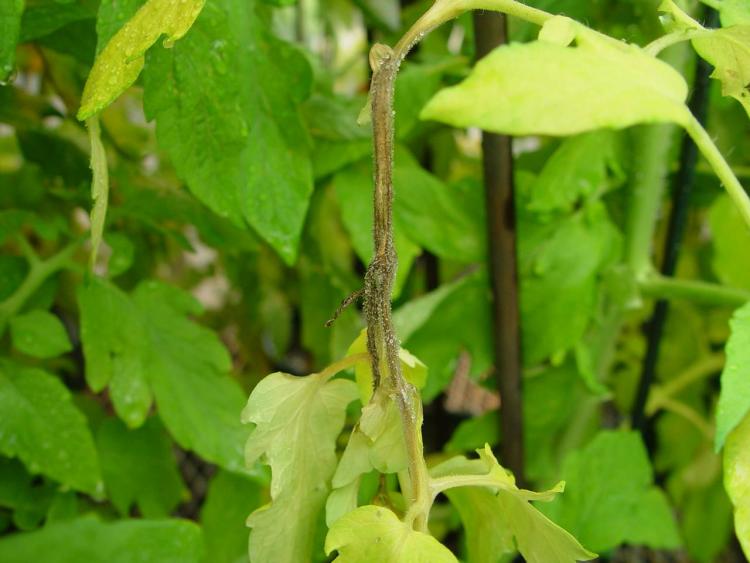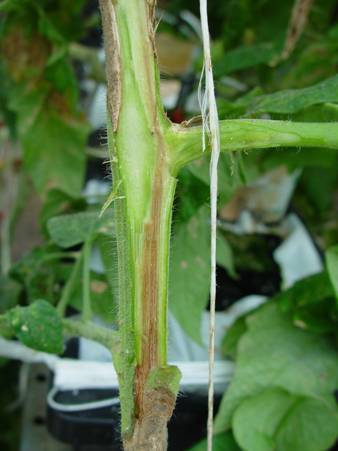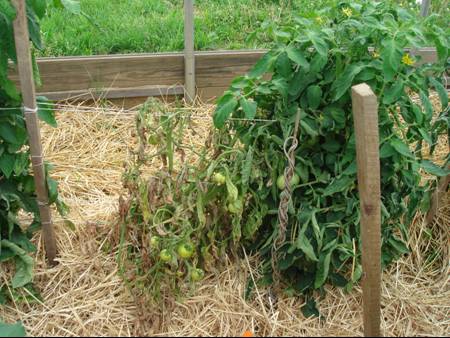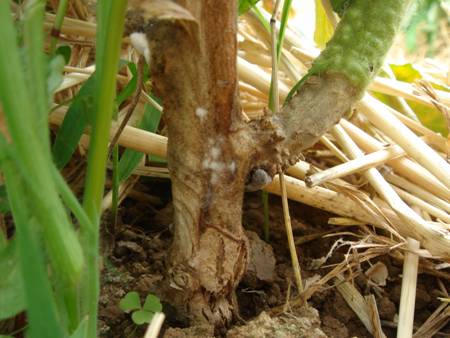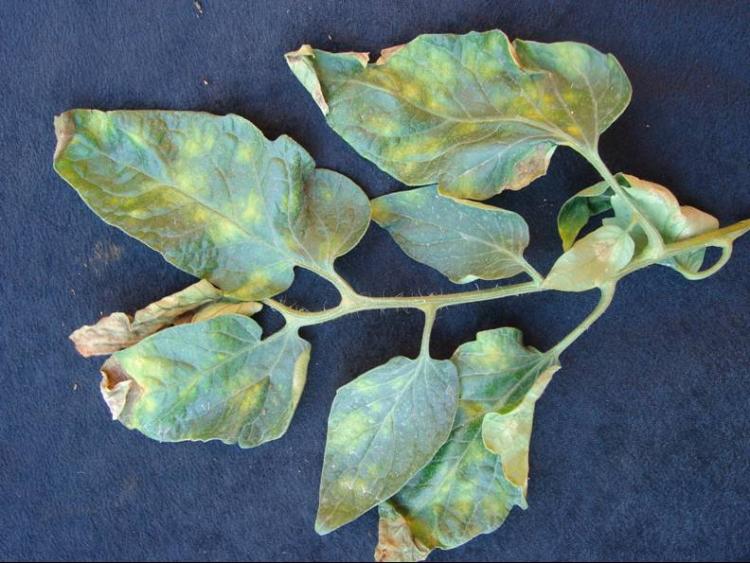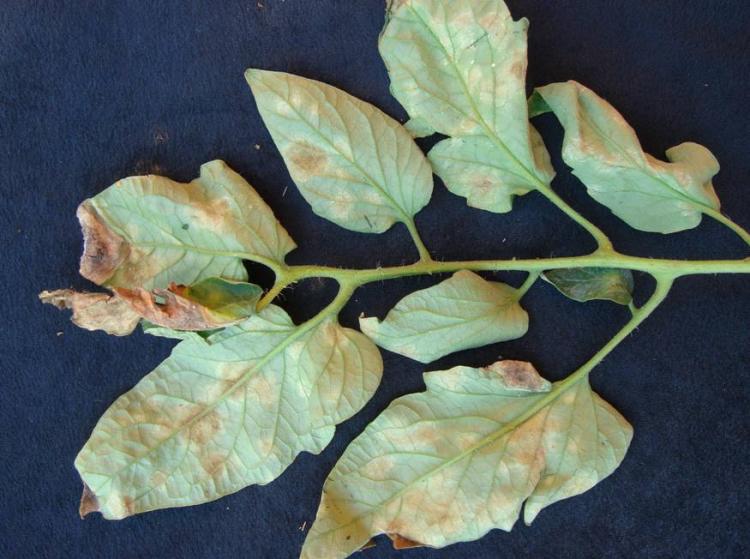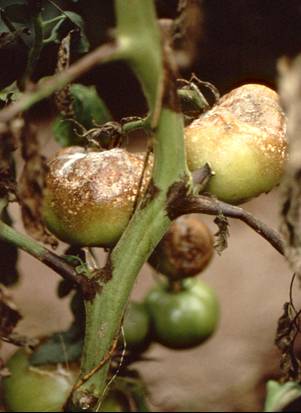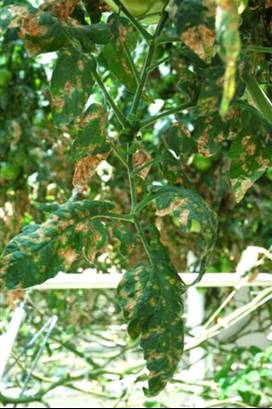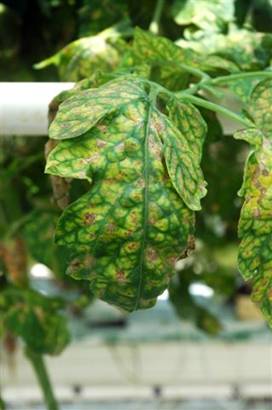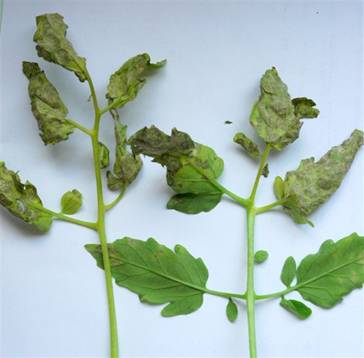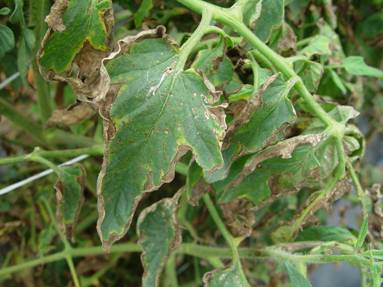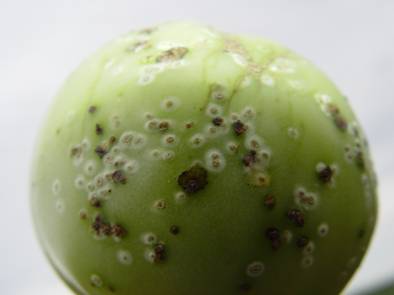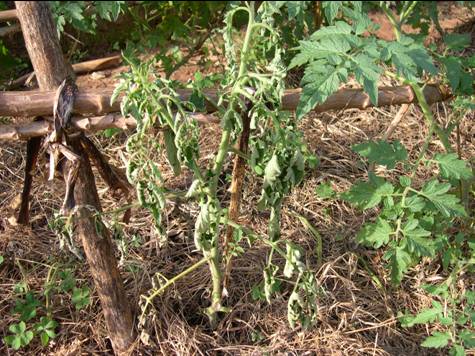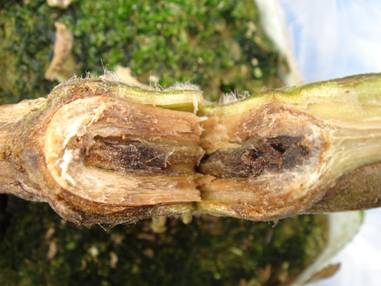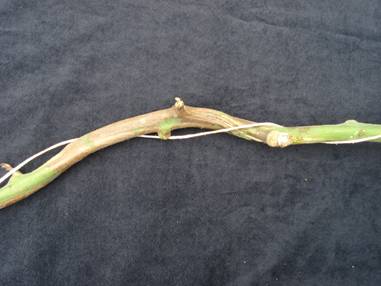eOrganic author:
Sally A. Miller, The Ohio State University
Introduction
Production of tomatoes in greenhouses and high tunnels has increased in popularity significantly in the last decade. Both provide the option of off-season production and expansion of markets over traditional outdoor field systems. While greenhouse tomato culture tends to be very high-tech and capital-intensive, high tunnels expand the growing season in both spring and fall with much lower capital investments. Greenhouse and high tunnel systems pose unique pest management challenges. The “protected culture” of greenhouse and high tunnel production may result in lower incidence of diseases exacerbated by rainfall, such as Septoria leaf spot and bacterial spot and speck. However, diseases that are uncommon in open fields may appear under protected culture. Botrytis blight/gray mold (Figure 1), white mold (timber rot) (Figure 2) and leaf mold (Figure 3) are among the most important of these diseases. Late blight (Figure 4) may also occur under cool, moist conditions, while powdery mildew has occurred in many greenhouses under drier conditions (Figure 5).
Figure 1: Botrytis blight/gray mold (Botrytis cinerea). Figure credit: Sally A. Miller, The Ohio State University
Figure 2: Tomato white mold (Sclerotinia sclerotiorum) in a high tunnel. Figure credit: Sally A. Miller, The Ohio State University
Figure 3: Tomato leaf mold (Fulvia fulvum), upper surface (left); lower surface (right). Figure credit: Sally A. Miller, The Ohio State University
Figure 4: Late blight (Phytophthora infestans) of tomato. Figure credit: Sally A. Miller, The Ohio State University
Figure 5a: Powdery mildew of tomato caused by Oidium neolycopersici and O. lycopersici. Figure credit: Sally A. Miller, The Ohio State University
Figure 5b. Powdery mildew of tomato caused by Leveillula taurica. Leveillula powdery mildew is sometimes erroneously called downy mildew because chlorotic spots on the upper surface and sporulation on the lower surface are reminiscent of downy mildew. Photo credit: John Zhang, Bionatur and DPA, Jacotitlan, Mexico.
Bacterial canker (Figure 6), caused by Clavibacter michiganensis subsp. michiganensis, is a very serious problem in both greenhouse and field tomatoes. Bacterial wilt is a serious disease in the southeastern US and in tropical and subtropical regions throughout the world (Figure 7). Pith necrosis, caused by a complex of bacteria, occurs sporadically in greenhouses but can kill plants outright, as well as contribute to a decline in productivity (Figure 8).
Figure 6: Bacterial canker of tomato (Clavibacter michiganensis subsp. michiganensis). Figure credit: Sally A. Miller, The Ohio State University
Figure 7: Bacterial wilt (Ralstonia solanacearum). Figure credit: Sally A. Miller, The Ohio State University
Figure 8: Tomato pith necrosis (Pseudomonas corrugata and other Pseudomonas spp., and Erwinia caratovora). Figure credit: Sally A. Miller, The Ohio State University
Viruses and viroids can wreak havoc in a greenhouse or high tunnel. Some, such as tomato spotted wilt virus (Figure 9) and tomato marchitez virus are transmitted by insect vectors, while others, such as tobacco mosaic virus (TMV, Figure 10) and pepino mosaic virus are mechanically transmitted (transmitted by people or tools that rub up against or cut or damage plant tissues). Still others are seedborne. Several viroids including tomato chlorotic dwarf viroid (TCDVd), Mexican pepita viroid and tomato planta macho viroid (Figure 11) have been identified in recent years causing severe problems in greenhouse tomatoes. The viroids are seedborne but are also easily mechanically transmitted.
Figure 11: Viroid symptoms in tomato. The viroid from plants with this symptom showed high similarities to Mexican pepita viroid and tomato planta macho viroid. Figure credit: John Zhang, Bionatur and DPA, Jacotitlan, Mexico.
These diseases can be managed by employing appropriate integrated pest management (IPM) approaches including cultural tactics, resistant varieties and applications of materials approved for use in organic production systems. For more information on disease management materials, see the eOrganic article Can I Use This Product for Disease Management on my Organic Farm?.
Management Strategies
Cultural Tactics
Soil quality and soilborne disease management
Organic tomatoes may be produced in “ground” culture on raised or flat beds in soil, in bag/pot culture using soilless planting mix, or in hydroponic culture. In the latter two systems, tomatoes are produced in a soilless planting mix or medium and fed nutrients in liquid form. A clear advantage of the soilless culture methods is the ability to replace contaminated planting mix and avoid many soilborne pathogens (although pathogens such as Pythium sp. can be a serious problem in bag/pot and hydroponic culture). For soil culture, improving soil quality is critical for optimal soil fertility and crop health. The addition of good quality compost is essential for increasing soil organic matter and providing nutrients for the crop. Further, research has shown that increased organic matter results in a more extensive and varied microbial community, resulting in suppression of soilborne pathogens and improved plant health. Our research has shown that tomato plants grown in compost-amended soil in high tunnels had significantly less white mold than those grown in non-amended soil. Early blight was also reduced on tomatoes grown in compost-amended soil compared to those grown in non-amended soil in high tunnels. If a soilborne pathogen problem develops, soil can be pasteurized or sterilized by a number of methods, although these can be costly. Details on soil and soilless culture methods can be found in ATTRA publications Organic Greenhouse Tomato Production, Organic Greenhouse Vegetable Production, and Integrated Pest Management for Greenhouse Crops. For more information on organic soil and fertility management see the eOrganic articles Conventional Chemical Soil Testing within Organic Systems and Organic Soil Fertility.
Rotation
Crop rotation is a cornerstone of disease management for organic crops, but may be difficult to achieve in greenhouses and high tunnels utilizing soil culture. High tunnels can be built as temporary structures that can be moved from one location to another (Figure 12). These high tunnels must be securely anchored in order to prevent structural damage during high winds. For immovable structures, crops should be rotated within the greenhouse between (not among!) plant families. For example, tomatoes should be rotated with vine crops, lettuce, or cole crops, for example. Unfortunately, there are some pathogens, such as Sclerotinia sclerotiorum, the causal agent of white mold (also known as timber rot), that have a wide host range and attack plants in different families. It is therefore important to scout plants regularly and know which diseases are present in the crop.
Figure 12: Hydraulic drill to secure anchors for moveable high tunnel. Figure credit: Sally A. Miller, The Ohio State University
*Management tip* When white mold is observed in a greenhouse or high tunnel, the diseased plants and soil immediately surrounding the stem (approx. 6-8 inch radius, 4-6 in. deep) that may contain sclerotia (Figure 13) should be removed immediately from the greenhouse and buried deeply in another location. Growers may also consider applying the biocontrol agent Contans to soil after the tomato crop to reduce the viability and number of sclerotia.
Figure 13: Sclerotia (arrows) of the white mold pathogen surrounding the base of the diseased tomato plant. Removing the plant and the soil surrounding the base from the high tunnel or greenhouse will remove inoculum. Figure credit: Sally A. Miller, The Ohio State University
Sanitation
Proper sanitation is critical in the greenhouse or high tunnel environment. Weeds, which may harbor insect pests and some pathogens, and also reduce air movement, should be removed from inside and outside the structure. Diseased tissue should be removed and disposed of. Cull piles are a source of inoculum and waste tissue should be composted or buried. If composting, choose a composting process that facilitates rapid decomposition and maintains the necessary high temperatures throughout the pile – preferably an active process in which the pile is turned frequently. The composting cull pile should be located as far away from the greenhouse or high tunnel as possible.
Surfaces should be cleaned thoroughly after each crop, and tools should be cleaned regularly. Workers should wash hands often – at least at the end of each row – to minimize spread of pathogens, particularly Botrytis grey mold, bacterial canker, TMV, PepMV and TCDVd. In some operations, workers wear gloves that can be regularly dipped into a sanitizing agent. Tomato greenhouse operations routinely use disinfectant-filled footbaths to prevent movement of pathogens on boots and shoes into the greenhouse. Pruning tools and knives are available that dispense a disinfectant solution during cutting and pruning operations, significantly reducing the risk of disease spread. There are a number of disinfectants/sanitizers permitted for use on organic farms. For more information, see the eOrganic articles Approved Chemicals for Use in Organic Postharvest Systems and Can I Use This Input on my Organic Farm?. Unfortunately, there are few independent studies available to guide the selection of a disinfectant or sanitizer for organic food crop production.
Workers who smoke should dip their hands into whole milk, followed by thorough washing in hot soapy water to inactivate tobacco mosaic virus, which may infect tomatoes. Workers should wear coveralls that are laundered often and stored in a smoke-free facility.
Bacterial canker is seedborne, so in order to avoid the possibility of transmission of this important pathogen from seed to seedlings to plants, seed should be hot water-treated prior to planting. Complete instructions for hot water treatment of vegetable seeds (Miller and Ivey 2005) are available.
Environmental management
All of the foliar fungal diseases are favored by high relative humidity in the tomato canopy. Wider plant spacing and improved ventilation help to reduce the incidence of these diseases. Tomato plants should be suckered below the first fruit set to promote air circulation. Removing the lower leaves as the plant ages also increases air movement around the plants. For high tunnels, the sides and ends should remain open as much as possible to promote air movement. Workers should avoid handling plants when free moisture is present to reduce the spread of pathogens from diseased to healthy plants. Plants should be irrigated without applying water to the foliage. In greenhouses, temperatures should be managed to reduce condensation, and fans or tubing can be used to distribute heated air throughout the structure.
Resistant Varieties
No tomato variety is resistant to every disease that may appear in the greenhouse or high tunnel. In fact, there are no commercially available sources of resistance to some of the most important diseases, such as bacterial canker and white mold. Further, very few heirloom varieties, often favored by organic producers, are resistant to diseases. Check with the seed supplier to determine if varieties with resistance to a problematic disease are available. Organic growers must use organically produced seed if available, but untreated seed that is conventionally produced is permitted if organically-produced stocks cannot be obtained. For more information on organic seed and suppliers, see Sourcing Certified Organic Seed and The National Organic Program (NOP) Regulations.
Nearly all of the tomatoes used in conventional greenhouse tomato production are grafted. The rootstocks used are not particularly disease-resistant, but impart higher vigor and prolonged plant life. Organic growers are beginning to experiment with grafting for soil-cultured tomatoes (Rivard and Louws 2006) particularly in areas where bacterial wilt, root knot nematode or other soilborne diseases are a problem. Preferred varieties are grafted onto disease-resistant rootstocks and allowed to heal before transplanting. While the cost of grafted transplants is higher than that of non-grafted ones, where soilborne diseases are a problem, this option may be more cost-effective than soil pasteurization or sterilization.
Fungicides
All of the diseases mentioned are difficult to manage once they become established, and the fungicides allowed in organic production usually cannot tame a raging disease epidemic. However, if diseases are identified early in the epidemic and all the appropriate cultural tactics have been employed, approved fungicides may be applied to reduce disease spread throughout the greenhouse or high tunnel. For powdery mildew, products containing fixed copper or sulfur can be effective. Fixed copper products are also effective in reducing the incidence and severity of leaf mold and early blight. Plant extracts and various biocontrol agents have shown some efficacy in reducing diseases in organic tomatoes, but they are generally less effective than fixed copper fungicides. However, coppers should not be overused as they may accumulate in soil and are toxic at high levels to soil flora and fauna.
NOTE: Before applying ANY pest control product, be sure to 1) read and understand the safety precautions and application restrictions, and 2) make sure that the brand name product is listed your Organic System Plan and approved by your certifier. For more information see Can I Use this Product for Disease Management on my Organic Farm, and for more information on the use of copper products, see Organic Management of Late Blight of Potato and Tomato with Copper Products.
References and Citations
- Contans WG biological fungicide [Online]. SipcamAdvan. Available at: http://www.sipcamadvan.com/products/contans-r (verified 1 Dec 2015).
- Grafting for disease resistance in heirloom tomatoes. C. Rivard and F. Louws. 2006. North Carolina Cooperative Extension Service Publication AG-675. (Available online at: https://content.ces.ncsu.edu/grafting-for-disease-resistance-in-heirloom-tomatoes)(verified 4 April 2011).
- Hot water and chlorine treatment of vegetable seeds to eradicate bacterial plant pathogens [Online]. S. A. Miller and M. L. Ivey, 2005. Ohio State University Extension Bulletin HYG-3085-05. Available at: http://ohioline.osu.edu/hyg-fact/3000/3085.html (verified 4 April 2011)
- Hot water treatment of vegetable seeds to eradicate bacterial plant pathogens in organic production systems [Online]. S. A. Miller and M. L. Ivey, 2005. Ohio State Extension Bulletin HYG-3086-05. Available at: http://ohioline.osu.edu/hyg-fact/3000/pdf/3086.pdf (verified 4 April 2011).
- Integrated pest management for greenhouse crops [Online]. L. Greer and S. Diver. 1999. National Sustainable Agriculture Information Service, ATTRA. Available at: https://attra.ncat.org/viewhtml/?id=48#xml=http://search.ncat.org/texis/search/pdfhi.txt?query=Greer&pr=ATTRA2010&prox=page&rorder=500&rprox=500&rdfreq=500&rwfreq=500&rlead=500&rdepth=0&sufs=0&order=r&cq=&id=4d99971465 (verified 4 April 2011).
- Organic greenhouse tomato production [Online]. M. Dodson, J. Bachmann, and P. Williams. 2002. ATTRA. Available at: https://attra.ncat.org/attra-pub-summaries/?pub=54 (verified 4 April 2011).
- Organic greenhouse vegetable production [Online]. S. Diver. 2000. ATTRA. Available at: https://attra.ncat.org/attra-pub-summaries/?pub=45 (verified 10 March 2010).
- Tomato disease in Mexico caused by new virus [Online]. ScienceDaily, LLC. 2007. Available at: http://www.sciencedaily.com/releases/2007/11/071130200450.htm (verified 4 April 2011).
- Testing compost [Online]. M.E. Watson. 2003. The Ohio State University Extension Publication ANR-15-03. Available at: http://ohioline.osu.edu/anr-fact/0015.html (verified 4 April 2011).
